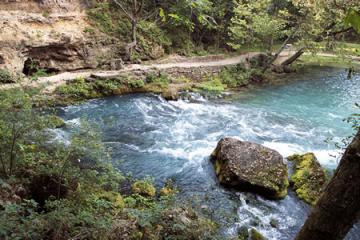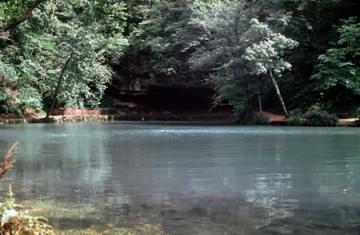Missouri Geological Survey Director: Carey Bridges, RG
Secrets of Missouri’s Spring Systems
Several springs bubble up in the sandy bottoms of deep pools in the wide valley of Montauk State Park in Dent County and feed the rushing force of nearby Current River. Near St. James, Maramec Spring wells up from a deep cave opening into a circular basin, spreads outward into a quiet lake, and then rushes over a falls and down the valley into the Meramec River.
During the late 1800s, Missouri’s saline springs or “mineral-waters” were believed to be of great medicinal value. More than 100 saline and mineral water springs were listed in an 1892 Geological Survey publication along with locations, chemical analyses and notes on their medicinal value. During the early 20th century, these springs enjoyed considerable attention because of their supposed medical applications, but little emphasis has been placed on their potential since then.
In the springs region of the Missouri Ozarks, the land is hilly and pitted with “funnel-like” structures known as sinkholes. The sinkholes help form a natural, efficient system of surface drainage. Just under the loose, rocky soil are massive layers of limestone and sandstone. Such formations are usually porous and limestone is often cavernous.

Missouri’s limestone beds have been compared to chunks of Swiss cheese or a large, dripping-wet sponge. These comparisons aptly illustrate the natural siphon and reservoir system they form. Natural drainage features include sinkholes, creeks, valleys, small streams and several feet of clayey, loose soil.
As surface waters gather force, they make deep cuts in soil and bedrock. Over the years, small streams may create rivers which dissect the landscape, leaving high bluffs along their banks. The whole story isn’t that simple though. For example, geologists puzzle over the eight known ebb-and-flow springs in the state. Are they siphons in cave systems that feed larger springs?
And what about Toronto Spring in Camden County, which rises from a sand bar in the middle of a creek? And why is Grand Gulf in Wayne County which is 200 feet deep, 600 feet long, and 100 feet wide, not connected with two nearby springs, and clogged with large trees and registers relatively warm temperatures?
How extensive is the air-filled cave passage closed by the water level of the spring at Roaring River State Park? And where does the water come from that forms the large lake in Devils Well in Shannon County?

Scientists are attempting to answer these and other questions. So far, many of the answers are mere hypotheses since much information is still to be gathered. Water levels, temperatures and daily flows are being measured and recorded all over the state. Scuba divers are exploring water-filled caves and have already discovered flooded beaches of white sand, an ancient dugout canoe, great empty caves behind walls of water, and the strange phenomena of rise-and-fall, warm and cool spring outlets.
While researchers continue to work to discover the secrets of Missouri’s spring systems, only a fraction of the spring waters available are being used for municipal or domestic supplies. The springs do, however, contribute indirectly to the economy by sustaining the flow of streams and by serving as focal points for a thriving and expanding recreation industry. Hundreds of springs have been developed in State Parks, National Forests and by private owners for public enjoyment.
Springs are generally places of unusual natural beauty. They provide fisherman a place to fish, artists a place to paint and families a place to play and enjoy life. Truly, Missouri springs are some of the state’s most important natural resources.
Learn more about and locate Missouri springs
Springs of Missouri - WR29 - Book
Nothing in this document may be used to implement any enforcement action or levy any penalty unless promulgated by rule under chapter 536 or authorized by statute.
For more information
Geological Survey Program
Missouri Geological Survey
P.O. Box 250
Rolla, MO 65402-0250
United States
